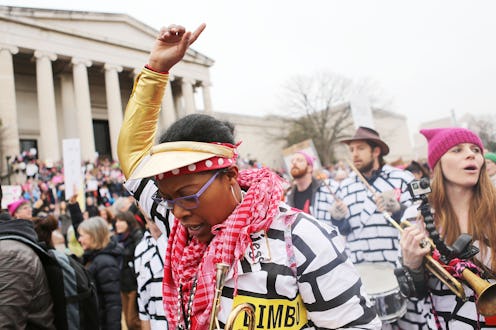
Though months have passed since the Women's March united women around the nation in January, its mission to stand up for the rights of those who are most vulnerable cannot afford to slip into the background. And this applies especially to women in Washington, D.C. right now. In particular, you should be helping to find D.C.'s missing girls if you participated in the Women's March in our nation's capital, because these girls need women like you to look out for them when no one else will. And there's no reason why women shouldn't unite around this issue as they did around the march in D.C. months ago.
According to the Associated Press, over 500 D.C. children went missing in the first three months of 2017. However, according to D.C. Metropolitan Police spokeswoman Rachel Reid, there hasn't necessarily been an increase in missing persons in the district. Instead, the public is simply noticing more because the police department is posting missing girls' photos on social media. In other words, these missing persons are finally being realized.
The problem is that when those children are African-American or Latinx, their disappearances don't gain adequate media coverage. Congressional Black Caucus chairman Cedric Richmond sent a letter to the Justice Department pleading that it helps to investigate these cases, writing:
Ten children of color went missing in our nation's capital in a period of two weeks and at first garnered very little media attention. That's deeply disturbing.
Law enforcement veteran Derrica Wilson echoed a similar point when she told Essence:
We know Blacks and Latinos or any persons of color who go missing, oftentimes don't receive much-needed media coverage, which could drastically increase the odds of their safe recovery.
As reported by Teen Vogue, PBS reporter Gwen Ifill has called this gap in coverage of white versus women of color "missing white woman syndrome." Take for example Natalee Holloway's or Elizabeth Smart's disappearances, the publication notes. They gained tons of media attention for days, if not weeks.
It takes effort to look outside of the box and think of ways to extend the Women's March mission to situations that extend past influencing the legislative process — but it is so important. And after reading the Women's March mission itself, how it applies to the missing girls in D.C., and in cities across the country, becomes crystal clear:
We support the advocacy and resistance movements that reflect our multiple and intersecting identities. We call on all defenders of human rights to join us. This march is the first step towards unifying our communities, grounded in new relationships, to create change from the grassroots level up. We will not rest until women have parity and equity at all levels of leadership in society. We work peacefully while recognizing there is no true peace without justice and equity for all.
Helping to draw even more attention to D.C.'s missing girls isn't unlike fighting for women's rights, abortion access, racial equality, or LGBT rights — all of which were intensely promoted by the Women's March. When it comes down to it, it's about representation. The march may be over, but those who support its promise to defend each other need to keep stepping up.
You can do so by retweeting or posting the photos of missing girls published on the D.C. Metropolitan Police Department's Twitter feed or by encouraging the Justice Department to lend its aid to these investigations. The Department comment line can be reached at 202-353-1555. No matter what you do, pay attention to the girls who go missing, keep a watchful eye, and continue to spread the word.